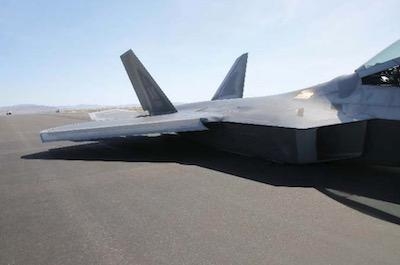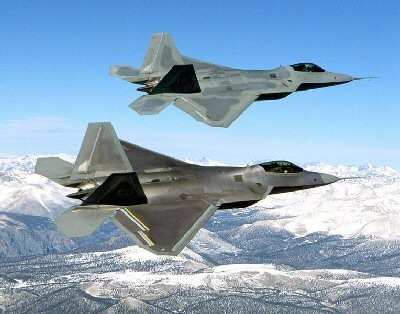Landing Gear Raised Prematurely During Takeoff, Pilot Was Uninjured
An investigation by the U.S. Air Force into an incident involving an F-22 Raptor on April 13 has found that the pilot prematurely retracted his landing gear, causing the airplane to skid on its belly for more than 6,000 feet.

The pilot was uninjured in the incident. He was able to raise the canopy of the aircraft after it came to a stop and exit the cockpit.
According to the report, the pilot was participating in a TOPGUN graduation exercise when the accident occurred at NAS Fallon, Nevada. The mishap pilot (MP) initiated a military power (MIL) takeoff and rotated at 120 knots calibrated airspeed (KCAS) (Tab DD-4). Rotation occurs when the pilot initiates back stick pressure to lift the nose of the aircraft off the ground and set the takeoff pitch attitude. Once the MP recognized his visual cues for takeoff, he raised the landing gear handle to retract the landing gear. After main landing gear retraction, the MA impacted the runway with all but the nose landing gear doors fully closed.
The mishap aircraft impacted approximately 2,905 ft from the runway threshold on the centerline and slid approximately 6,514 ft until it came to rest 9,419 ft from runway threshold. While the MA was sliding down the runway, the MP shut off both engines. Once the plane was at a complete stop, the pilot safely exited the airplane. There were no injuries, fatalities, or damage to civilian property.
A normal F-22 takeoff ends when the pilot ensures that a positive rate of climb is established and retracts the LG. Common indicators of a positive rate of climb in the F-22 include visual cues, the climb dive marker (CDM) above the horizon, and an increasing vertical velocity indicator (VVI). Takeoff should occur at calculated takeoff speed, and landing gear should be retracted after the airplane is safely airborne. Therefore, landing gear retraction should not occur prior to takeoff speed.

During the mishap sortie, after rotation and achieving weight off wheels, the pilot described using peripheral vision, and the surroundings getting smaller to determine he was airborne. He quickly retracted the landing gear upon recognizing those visual cues. He did not utilize the CDM or VVI to verify a positive rate of climb. While the pilot sensed that the aircraft was airborne and raised the landing gear handle 1.0 second after weight off wheels, the aircraft’s speed was 22 knots below takeoff speed. The lift being generated at this point was insufficient to maintain flight, which resulted in the aircraft settling back to the runway on its belly.
The report also found that the Takeoff and Landing Data provided to the pilot was incorrect. The data was calculated for 80 degrees (F) and not recalculated for each airfield prior to takeoff. The temperature on the day of the accident was 46 degrees (F). The report further indicates that the flight brief before the accident flight was "inadequate".
The report cites two procedural errors leading to the accident: First, the pilot had incorrect Takeoff and Landing Data (TOLD) for the conditions at NAS Fallon on the day of the mishap, and more importantly, he failed to apply any corrections to the TOLD during his takeoff sequence. Second, the pilot prematurely retracted the landing gear at an airspeed that was insufficient for the aircraft to maintain flight.
(Images from Air Force report and from file)
 Classic Aero-TV: Remembering Bob Hoover
Classic Aero-TV: Remembering Bob Hoover ANN FAQ: Follow Us On Instagram!
ANN FAQ: Follow Us On Instagram! ANN's Daily Aero-Linx (05.15.24)
ANN's Daily Aero-Linx (05.15.24) ANN's Daily Aero-Term (05.15.24):Altimeter Setting
ANN's Daily Aero-Term (05.15.24):Altimeter Setting Aero-News: Quote of the Day (05.16.24)
Aero-News: Quote of the Day (05.16.24)




